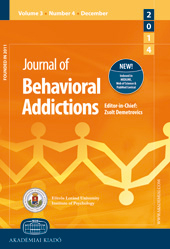Classification of problematic Internet usage types by motives and contexts with elementary and secondary school-aged counseling clients
Classification of problematic Internet usage types by motives and contexts with elementary and secondary school-aged counseling clients
Author(s): Bugeun Kim, Seul Lee, Young Yim Doh, Gahgene GweonSubject(s): Behaviorism
Published by: Akadémiai Kiadó
Keywords: problematic Internet use; usage types; usage context; usage motive; symptom; elementary and secondary school-aged counseling clients
Summary/Abstract: Background and aims. Past research on the classification of problematic Internet use (PIU) has focused on symptom-based severity and usage motive in order to understand its mechanism. Recently, usage context, such as family or social relationships, has been identified as a key influencing factor of PIU. Therefore, we extended the classification of PIU to include usage context in addition to symptom-based severity and usage motive. Methods. To classify PIU types, we conducted two studies. First, we performed a clustering analysis, where 265 counseling cases were clustered into usage types in terms of motive and context. After characterizing each usage type, we examined their hierarchical relationships by considering symptoms. Second, we performed a focus group interview with six counselors to increase the transferability of usage types. This transferability was established by matching counselors’ quotations to the usage types. When usage types showed consistency between quotations and the clustering analysis, we identified the progression patterns between hierarchical relationships. Results. The clustering analysis of motive and context yielded six usage types with three hierarchical relationships. The focus group interview results verified the transferability of these six types and identified two progression patterns between the hierarchical relationships. Discussion and conclusion. Although usage motive and context were given equal weight before the clustering analysis, the resulting types revealed that usage context played a greater role in the classification process.
Journal: Journal of Behavioral Addictions
- Issue Year: 7/2018
- Issue No: 3
- Page Range: 644-653
- Page Count: 10
- Language: English

